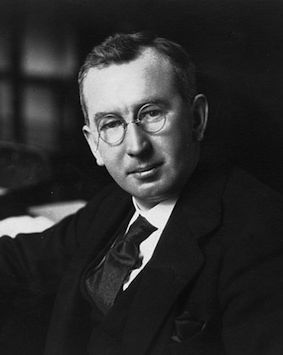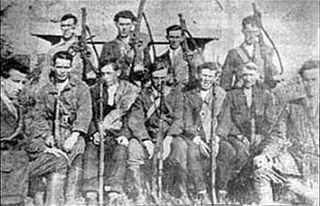
Fionán Lynch was an Irish revolutionary, barrister, politician and judge of the Circuit Court from 1944 to 1959, Leas-Cheann Comhairle of Dáil Éireann from 1938 to 1939, Minister for Lands and Fisheries from 1928 to 1932, Minister for Fisheries from 1922 to 1928, Minister without portfolio from August 1922 to December 1922 and Minister for Education from April 1922 to August 1922. He served as a Teachta Dála (TD) from 1918 to 1944.

Thomas Bernardine Barry, better known as Tom Barry, was a prominent guerrilla leader in the Irish Republican Army (IRA) during the Irish War of Independence and the Irish Civil War. He is best remembered for orchestrating the Kilmichael ambush, in which he and his column wiped out a 18-man patrol of Auxiliaries, killing sixteen men.

Joseph McGrath was an Irish politician and businessman. He was a Sinn Féin and later a Cumann na nGaedheal Teachta Dála (TD) for various constituencies; Dublin St James's (1918–1921), Dublin North West (1921–1923) and Mayo North (1923–1924), and developed widespread business interests.

William Joseph Mellows was an Irish republican and Sinn Féin politician. Born in England to an English father and Irish mother, he grew up in Ashton-under-Lyne before moving to Ireland, being raised in Cork, Dublin and his mother's native Wexford. He was active with the Irish Republican Brotherhood and Irish Volunteers, and participated in the Easter Rising in County Galway and the War of Independence. Elected as a TD to the First Dáil, he rejected the Anglo-Irish Treaty. During the Irish Civil War Mellows was captured by Pro-Treaty forces after the surrender of the Four Courts in June 1922. On 8 December 1922 he was one of four senior IRA men executed by the Provisional Government.
James Colbert was an Irish revolutionary, politician and farmer.
Shake Hands with the Devil is a 1959 British-Irish film produced and directed by Michael Anderson and starring James Cagney, Don Murray, Dana Wynter, Glynis Johns and Michael Redgrave. The film was based on the 1933 novel of the same title by Rearden Conner, the son of a Royal Irish Constabulary policeman.

The executions during the Irish Civil War took place during the guerrilla phase of the Irish Civil War. This phase of the war was bitter, and both sides, the government forces of the Irish Free State and the anti-Treaty Irish Republican Army (IRA) insurgents, used executions and terror in what developed into a cycle of atrocities. From November 1922, the Free State government embarked on a policy of executing Republican prisoners in order to bring the war to an end. Many of those killed had previously been allies, and in some cases close friends, of those who ordered their deaths in the civil war. In addition, government troops summarily executed prisoners in the field on several occasions. The executions of prisoners left a lasting legacy of bitterness in Irish politics.
Stephen Fuller was an Irish Fianna Fáil politician who served as a Teachta Dála (TD) for the Kerry North constituency from 1937 to 1943.
The Kerry Senior Hurling Championship is an annual hurling competition organised by the Kerry County Board of the Gaelic Athletic Association since 1889 for the top hurling teams in the county of Kerry in Ireland.

Paddy Daly (1888–1957) sometimes referred to as Paddy O'Daly, served in the Irish Republican Army during the Irish War of Independence and subsequently held the rank of major-general in the Irish National Army from 1922 to 1924.

John Joe Rice was an Irish Sinn Féin politician who served as a Teachta Dála (TD) for the Kerry South constituency from 1957 to 1961.

Thomas H. O'Shea was an Irish revolutionary and one of the founders of the Transport Workers Union of America (TWU), subway workers in New York City that expanded to represent members in other forms of transit nationwide. O'Shea was appointed the first President of the TWU in 1934 and later ousted and replaced by longtime TWU President Michael J. Quill. O'Shea subsequently spent some years battling reported Communism within the union culminating in his 1940 testimony before the House Committee on Un-American Activities chaired by Rep. Martin Dies of Texas and commonly referred to as the Dies Committee at the time.

The guerrilla phase of the Irish Civil War began in August 1922, when the forces of the Irish Free State took all the fixed positions previously held by the Anti-Treaty IRA. The IRA then waged a guerrilla war to try to bring down the new Irish Government and overturn the Anglo-Irish Treaty. This guerrilla campaign was ultimately defeated.

The National Army, sometimes unofficially referred to as the Free State army or the Regulars, was the army of the Irish Free State from January 1922 until October 1924. Its role in this period was defined by its service in the Irish Civil War, in defence of the institutions established by the Anglo-Irish Treaty. Michael Collins was the army's first commander-in-chief until his death in August 1922.

George O'Shea was an Irish Republican Army (IRA) soldier who fought with the Anti-Treaty side during the Irish Civil War. He was one of eight men killed by Free State forces in the Ballyseedy Massacre, a defining event in Irish history.

Timothy Lyons, a.k.a. Aero or Aeroplane, was an Irish Republican Army (IRA) soldier who fought with the Anti-Treaty side during the Irish Civil War. After a three-day siege by Free State forces at Clashmealcon, County Kerry, he died after falling from a cliff onto rocks and then being shot.
Reginald Walter Stenning was a British Army deserter who joined the Irish Republican Army (IRA), fighting on the anti-Treaty side in the Civil War. After being captured by Free State forces he was beaten and executed.
James McEnery was a farmer and IRA soldier who fought on the anti-Treaty side in the Irish Civil War in north Kerry. He surrendered during a three-day siege by Free State forces, in the last significant action of the War, and was executed seven days later.
Edmond Greaney [also 'Edward', 'Eamonn/Eamon' and 'Greany' on historical documents] was a farm labourer and IRA soldier who fought on the anti-Treaty side in the Irish Civil War in north Kerry. He was captured by Free State forces and executed after the last major action of the War.
Patrick O'Shea was a farm labourer and IRA soldier who fought on the anti-Treaty side during the Irish Civil War in north Kerry. He died after falling from a cliff trying to escape from Irish Free State forces in a siege at Clashmealcon in the last major military action of the civil war.











